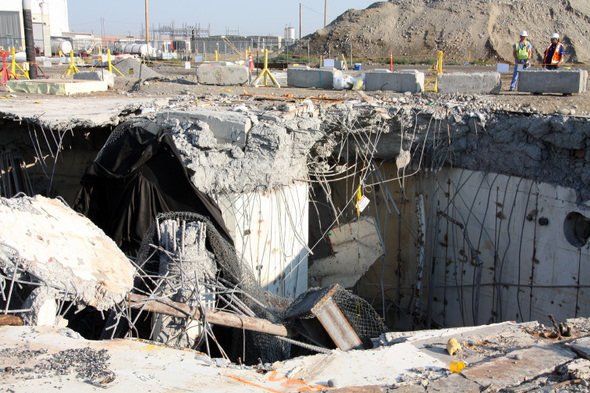 |
The underground demolition occurred at the final reactor cleanup site in Hanford's 300 Area, a former industrial complex along the west bank of the Columbia River.
RICHLAND, Wash. – Some people in the community heard an explosion the morning of Aug. 16 that heralded another significant step in environmental cleanup at EM's Hanford site.
The noise and small plume of dust just 1.5 miles north of the city came from an underground demolition explosion safely completed with a unique approach that protected workers and saved taxpayers $2.5 million. Watch a video of the demolition here.*
In January, the last of six test reactors was removed from the site where the demolition took place. The 1,082-ton Plutonium Recycle Test Reactor was lifted and transported to the site's Environmental Restoration Disposal Facility. Work associated with the massive underground structure that supported and shielded the test reactor was deferred until the best approach could be determined.
Reaching as far as 60 feet below the surface, the structure had walls ranging in thickness from 5 to 13 feet and was covered by a 5-foot-thick main deck. The largest block of reinforced concrete was 18 feet long, 13 feet thick, and 28 feet high.
"Some walls and the deck were made of a heavy aggregate concrete, which is almost twice as dense as regular concrete," said EM Richland Operations Office Federal Project Director Mark French. "This made the demolition especially challenging."
In operation in the 1960s, it was the largest of Hanford's experimental reactors used for developing and testing alternative fuels for the commercial nuclear power industry.
Preparations to remove the underground structure began in January when the reactor was lifted and hauled away. Workers removed piping and drums of contaminated materials. They also grouted hard-to-reach areas while applying fixative to areas with surface contamination.
Controlled Demolition Incorporated — which had previously performed the stack and 337 Building demolition in the 300 Area — was again hired by the site's cleanup contractor Washington Closure Hanford to do the work. Controlled Demolition drilled approximately 300 holes loaded with explosives into the deck, columns, and walls.
The blast effects were mitigated by a dust barrier placed on top of the structure, and mist to suppress dust.
"This is a safer approach than to have the deck dismantled with machinery from above and working down into the structure," said Rob Cantwell, director of closure operations for Washington Closure.
Their approach brought a cost savings of about $2.5 million compared to doing the same work with traditional demolition techniques.
The rubble from the demolition explosion is expected to be removed by January 2015 and the area will be sampled. If it meets cleanup standards, some of the remaining structure will be buried in place. If not, a second demolition explosion will be scheduled.
*Users who experience issues viewing video should consider updating their Internet browsers and/or using an alternate browser.
Follow us at @AmericanNewsSer on Twitter
No comments:
Post a Comment